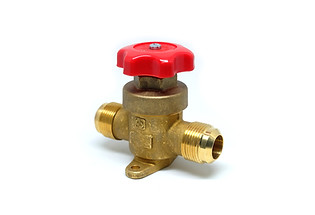
VALVES

Access Valve
A fin comb, also known as a coil fin tool, is a specialty tool used to straighten the bent fins of a condensing unit for an air conditioning or heat pump system.

Airvent
When liquid is pumped through the system at startup, the initial air inside the piping is pushed into the air vent by the pressure of the flow. The float remains in the lower part of the air vent, allowing the valve to remain open and continuously discharge air.
After the initial air venting, liquid flows into the air vent. The float rises with the rising liquid and closes the valve.
If air enters the air vent while it is closed, the liquid level drops and the float lowers, allowing the valve to open and discharge air once more.

Angle Valve
An angle valve is a fluid regulating device used in plumbing and industry.
It has inlet and outlet ports aligned at an angle with respect to each other, the most common angle being 90 degrees. The inlet and outlet ports can be threaded for connecting to galvanized steel and iron pipes, or they can have compression fittings for connecting to copper pipes. When an angle valve is used as a shut-off valve for residential plumbing fixtures, it is called an angle stop valve, or simply an angle stop

Automatic
Balancing Valve
Maintains the designed flow rate within the psid range, specified by the manufacturer’s, even as the system pressure varies. Provides system stability as it reacts to maintain overall system balance even when other branches modulate. Full authority temperature control can be thereby achieved. Acts as a pressure differential regulator at all varying load conditions by absorbing additional system pressure changes within the valve itself. Constant “Flow rate” operation.
Applications include fan coils, VAV, branch lines, pumps, heating or cooling systems, multiple boiler arrangements, radiant lines, and terminal vents.

Balancing Valve
The main purpose of a balancing valve is generally to create a consistent output pressure to a system from an inconsistent input pressure from a different system. This creates balance for the flow of the material being moved through the pressurized system as a whole.
In most cases, these types of valves are also used as a means of creating a stable flow of material within an unstable system. Sometimes, to facilitate this purpose, the balancing valve must release a set amount of material if the pressure within the system builds too quickly.

Gate Valve
Gate Valves are widely used in fluid-handing systems for flow control, Typical gate valves are designed to be fully opened or closed. When fully open, the typical gate valve has no obstruction in the flow path, resulting in very low friction loss.

Hand Valve
Hand Shut Off Valves suitable for use in refrigeration systems.

Ball Valve
A ball valve is a form of quarter-turn valve which uses a hollow, perforated and pivoting ball to control flow through it. It is open when the ball’s hole is in line with the flow and closed when it is pivoted 90-degrees by the valve handl
.jpg)
Globe Valve
The globe valve is used for throttling flow control. Shut off is accomplished by moving the disc against the flow stream rather than across it as in the case with a gate valve. The flow pattern through a globe valve involves changes in direction, resulting in greater resistance to flow, causing high pressure drop.

Motorized Valve
A motorized valve is a valve that use an electric motor to open or close its mechanism. This type of valve is ideally suited to very large valve types or remote fluid control applications such as aircraft deicing, agricultural irrigation, and automated fire suppression.
Most valve types are suited for motorized applications with some commonly used types being gate, ball, and butterfly. The motorized valve is also well suited to remote flow control applications where system inputs involve incremental valve operation.
The internal fluid control mechanisms of motorized valves are generally identical to their manual counterparts; valve actuation inputs are the only difference between the two.
CONTACT
Head Office
URASI Building
431 Sales Street, Quiapo, Manila,
Metro Manila, Philippines 1001
(02) 5310-2280
(02) 8733-8371
(02) 5310-2280 loc 5
(02) 8733-8371 loc 5
Uniform Refrigeration and Air-Conditioning Supply Inc
INQUIRIES
For any inquiries, questions or commendations, please fill out the following form: